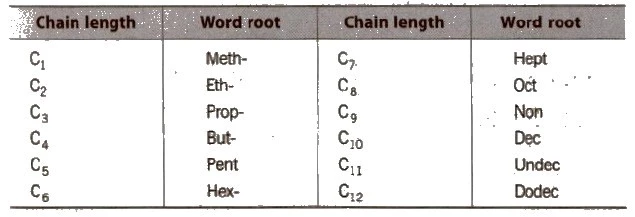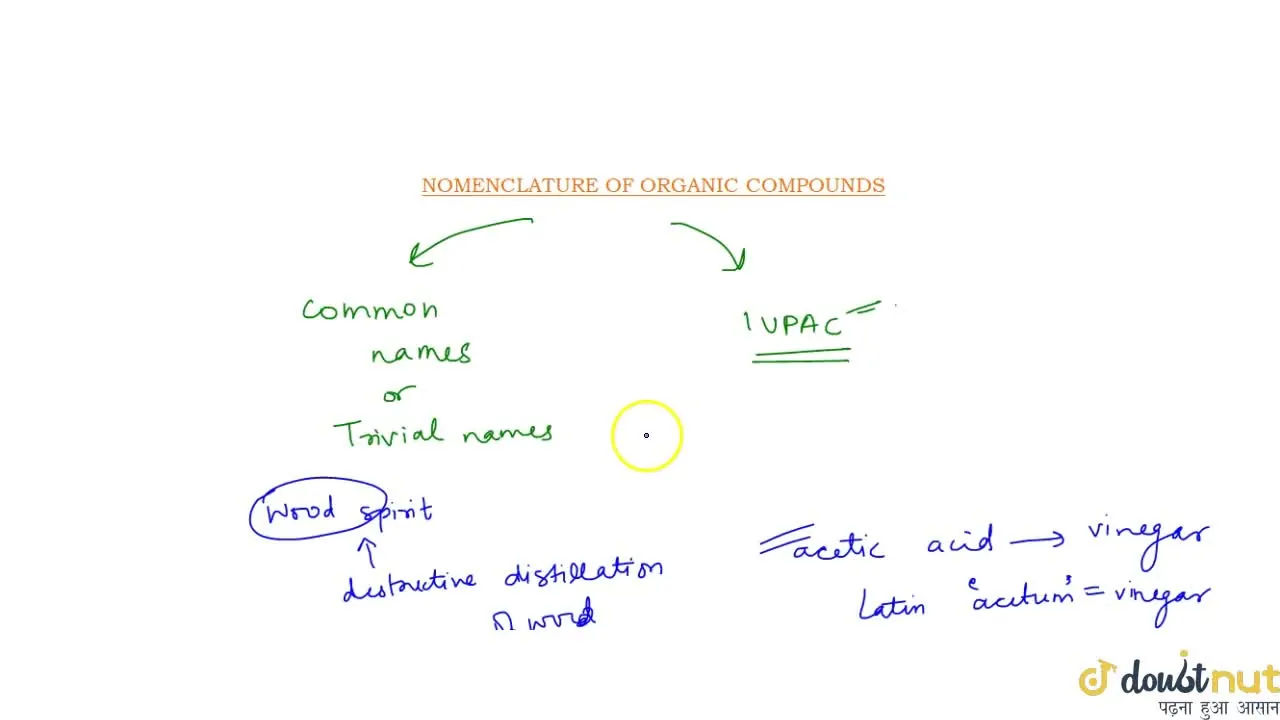Common Names
Nomenclature of Organic Compounds, Types, Rules & Issues
Nomenclature means the system of assigning a name to a compound. The hydrocarbons and their derivatives are called organic compounds. A large number of organic compounds are identified every year and together with the fact that many of these organic compounds are isomers of other organic compounds; therefore, the development of a systematic nomenclature system is a must. Just like every separate compound has an exclusive molecular structure that can be designated by a structural formula, each compound must be given a characteristic and unique name.
Types of Nomenclature
In the case of organic compounds, there are two naming systems:
- Common or trivial system
- IUPAC system
Trivial System
The trivial or common names are specified based on the source and various properties of organic compounds.
Eg: Citric acid is named, as it is found in citrus fruits.
Characteristics of the Trivial System
In Chemistry, a non-systematic manner or vernacular name for an organic compound is what is known as a trivial system. There are no specific set of rules for the trivial name of the compound. A trivial name is usually a common name, not a formal name.
In this naming system, names are usually common like acetic acid, citric acid, toluene, and phenol, etc. For example, the carbolic acid that we typically find in tamarind is called tartaric acid. But in the IUPAC system, it will be 2,3-dihydroxy-1,4-Butanedioic acid.
Issues with Trivial system
1. Chemical properties such as the molecular structure of a chemical compound are not specified in the trivial system.
2. Sometimes, trivial names can be unclear or will indicate different meanings in various industries or in different regions. For example, a trivial name such as white metal can represent various things.
3. There are no standard guidelines for naming complex compounds.
IUPAC Nomenclature
In 1947, the IUPAC ( International Union of Pure and Applied Chemistry) system of naming compounds was first developed. The IUPAC system is a systematic naming system in which the name of a compound correlates to its molecular structure.
The trivial nomenclature system had its drawbacks as mentioned above, so systematic nomenclature was required. Therefore, a rational nomenclature system of organic compounds should provide at least two things. Firstly, it should indicate how the carbon atoms of a given compound are bonded together in the form of chains and rings. Secondly, it should identify and locate any functional groups present in a particular compound. Since hydrogen atom is such a common component of organic compounds, the amount and locations of a hydrogen atom can be presumed from the carbon tetravalency.
The IUPAC nomenclature system is a set of logical rules developed and used by organic chemists to circumvent problems produced by arbitrary nomenclature. With these rules and structural formula, one should be able to write an exclusive name for every distinct compound. Likewise, given an IUPAC name, one should be able to estimate a structural formula. In general, an IUPAC name has three essential parts:
• A root or base indicates a major chain or ring of carbon atoms found in the molecular structure.
• A suffix or other element(s) designates functional groups that may be present in the compound.
• Names of substituent groups, except hydrogen, that complete the molecular structure.
IUPAC Rules to Write the name of an Organic Compound
1. Longest chain rule: The hydrocarbon chain carrying the principal functional group, secondary functional group, and the multiple bonds is the longest chain.
When the functional group, secondary group, and multiple bonds, are absent, then the chain containing the maximum number of Carbon-atoms will be the longest possible chain

2. Lowest number rule: The numbering is done in such a way that:
- Branching, if present, gets the lowest number
- The sum of the number of the side chain is the lowest.
- Principal functional group gets the lowest number.
3. Naming the prefixes and suffixes: In an organic compound, a prefix indicates the substituent, and a suffix denotes the principal functional group.
- The primary prefix Indicates whether the molecule is cyclic or not. For example, for cyclic compounds, the prefix used is cyclo.
- The secondary prefix indicates the presence of substituent groups or any side chain.
Key prefixes are cycle, bicycle, di, tri, tetra, tries, tetrakis, etc. Key suffixes includeene, ane, or yne, used for double, single and triple bonds respectively.
Therefore, as per the rules. given above, the final IUPAC name of a compound can be mentioned as Locant + Prefix + Root + Locant + Suffix.
Alkanes
Hydrocarbons that do not have any double or triple bond functional groups are termed as alkanes or cycloalkanes, depending on whether the carbon atoms of the molecule are arranged only in chains or also in rings.
Although the particular hydrocarbons have no functional groups, still they create the framework on which the functional groups are found in other classes of compounds. They provide an ideal starting point for studying and naming organic compounds.
Alkanes have both trivial or common names and systematic names, specified by IUPAC.
The alkanes and cycloalkanes are members of a larger class of compounds classified as aliphatic compounds. Aliphatic compounds do not include any aromatic rings in their molecular structure.
Name
Molecular
Formula
Structure
Formula
Isomers
methane
CH4
CH4
1
ethane
C2H6
CH3CH3
1
propane
C3H8
CH3CH2CH3
1
butane
C4H10
CH3CH2CH2CH3
2
pentane
C5H12
CH3(CH2)3CH3
3
hexane
C6H14
CH3(CH2)4CH3
5
heptane
C7H16
CH3(CH2)5CH3
9
octane
C8H18
CH3(CH2)6CH3
18
nonane
C9H20
CH3(CH2)7CH3
35
decane
C10H22
CH3(CH2)8CH3
75
IUPAC Rules for Alkane Nomenclature
1. Locate and name the longest continuous carbon chain.
2. Name groups attached to that longest chain.
3. Number the chain consecutively, beginning at the end nearest a substituent group.
4. Denote the location of each substituent group by a number and name.
5. Gather the name, listing groups in alphabetical order using the full name (e.g. cyclopropyl before isobutyl).
The prefixes di, tri, tetra, etc, used to label several groups of the same kind, are not considered when alphabetizing.
Alkenes and Alkynes
Alkenes and alkynes are hydrocarbons that respectively have carbon-carbon double bond and carbon-carbon triple bond functional groups. The molecular formulas of the particular unsaturated hydrocarbons reflect the multiple bonding of the functional groups.
IUPAC Rules for Alkene and Cycloalkene Nomenclature
1. The ‘ene’ suffix (ending) designates an alkene or cycloalkene.
2. The longest chain picked for the root name should include both carbon atoms of the double bond.
3. The root chain should be numbered from the end nearest a double bond carbon atom. If the double bond is in the center of the chain, the nearest substituent rule is applied to determine the end where numbering starts.
4. The smaller of the two numbers labeling the carbon atoms of the double bond is used as the double bond locator. If there is more than one double bond then the compound is termed as a diene, triene or equivalent prefix representing the number of double bonds, and each double bond is assigned a locator number.
5. In cycloalkenes, the double bond carbons are allocated to ring locations #1 and #2. Which of the two is #1 may be determined by the nearest substituent rule.
6. The substituent groups containing double bonds are:
H2C=CH– Vinyl group
H2C=CH–CH2- Allyl group
IUPAC Rules for Alkyne Nomenclature
1. The ‘yne’suffix (ending) represents an alkyne or cycloalkyne.
2. The longest chain picked for the root name should include both the carbon atoms of the triple bond.
3. The root chain should be numbered from the end nearest a triple bond carbon atom. If the triple bond is present in the center of the chain, the nearest substituent rule will be applied to determine the end where numbering begins.
4. The smaller of the two numbers labeling the carbon atoms of the triple bond is used as the triple bond locator.
5. If there are several multiple bonds, then each multiple bonds should be assigned a locator number. Double bonds come first before triple bonds in the IUPAC name, but the chain is numbered from the end nearest multiple bonds, regardless of nature.
6. Since the triple bond is linear, therefore, it can only be accommodated in rings larger than ten carbons.
7. Substituent groups containing triple bonds are:
HC≡C– Ethynyl group
HC≡C–CH2– Propargyl group
• A suffix or other element(s) designates functional groups that may be present in the compound.
• Names of substituent groups, except hydrogen, that complete the molecular structure.

Name
Molecular
Formula
Structure
Formula
Isomers
methane
CH4
CH4
1
ethane
C2H6
CH3CH3
1
propane
C3H8
CH3CH2CH3
1
butane
C4H10
CH3CH2CH2CH3
2
pentane
C5H12
CH3(CH2)3CH3
3
hexane
C6H14
CH3(CH2)4CH3
5
heptane
C7H16
CH3(CH2)5CH3
9
octane
C8H18
CH3(CH2)6CH3
18
nonane
C9H20
CH3(CH2)7CH3
35
decane
C10H22
CH3(CH2)8CH3
75
4. Denote the location of each substituent group by a number and name.
5. Gather the name, listing groups in alphabetical order using the full name (e.g. cyclopropyl before isobutyl).
2. The longest chain picked for the root name should include both carbon atoms of the double bond.
Similar Questions
Introduction and common Name
View SolutionCommon name of Fungia is
View SolutionCommon name of DDT is
View SolutionCommon name of Octopus is
View SolutionCommon Naming || Miscelleneous Questions
View SolutionCommon name of phenol is :
View SolutionCommon name of ethyl isocynide is
View SolutionCommon name of fish Anguilla is
View SolutionCommon name of Fungia is
View SolutionCommon name of paddy pest Leptocorisa is
View Solution


